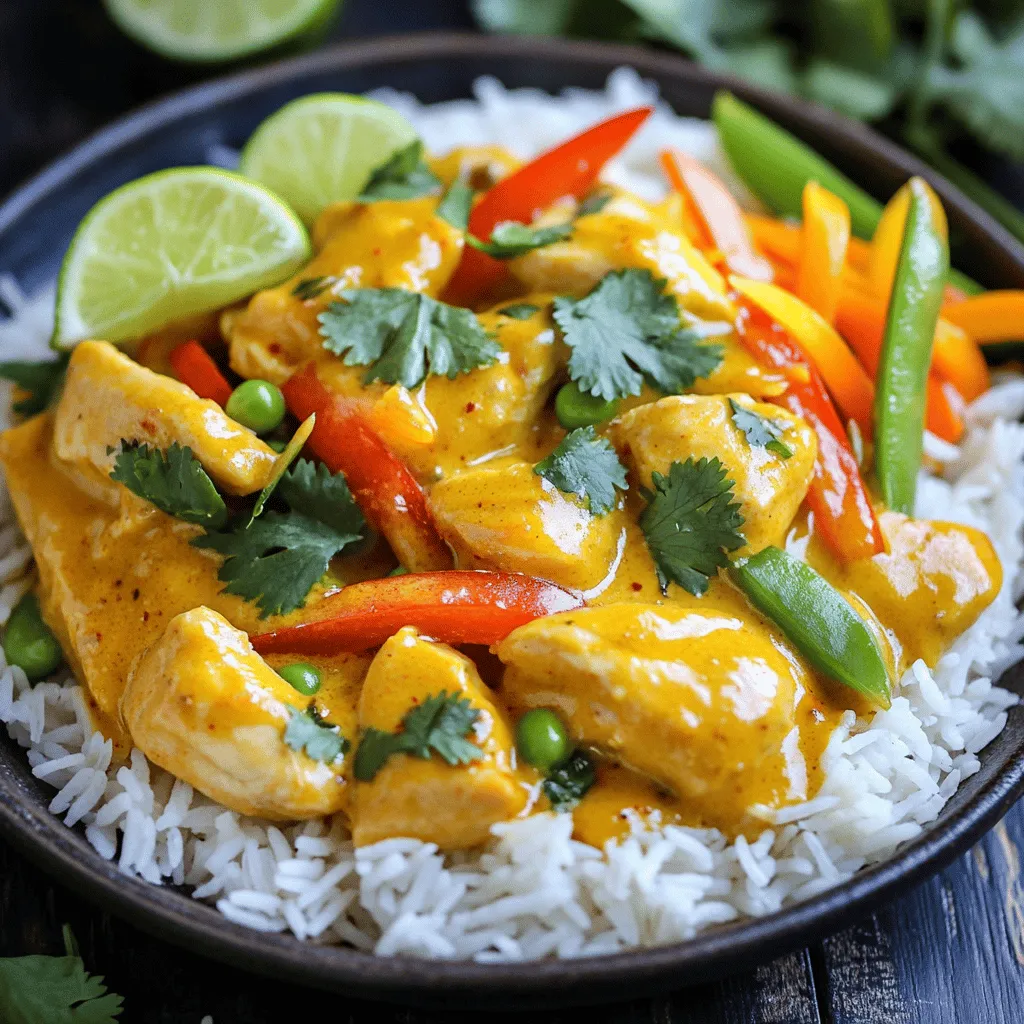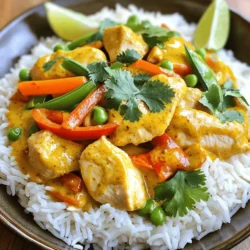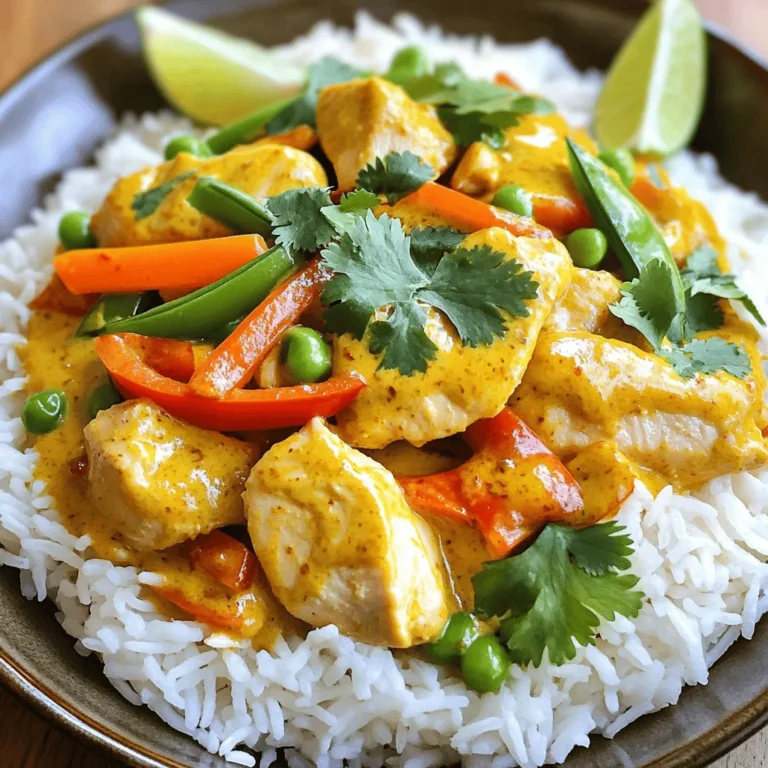If you’re craving a dish that’s bursting with flavor yet simple to make, you’ll love this Coconut Curry Chicken recipe. With just a handful of ingredients, you can whip up a meal that dazzles your taste buds. Imagine tender chicken mixed with rich coconut milk and aromatic spices. It’s a warm hug in a bowl! Let’s dive into how you can create this delightful dish in no time.
Ingredients
Cooking Coconut Curry Chicken is fun and easy. You need fresh, tasty ingredients to make it great. Here’s what you will need:
– 1 lb boneless chicken thighs, cut into bite-sized pieces
– 1 can coconut milk
– 2 tablespoons red curry paste
– 1 tablespoon vegetable oil
– 1 medium onion, diced
– 3 cloves garlic, minced
– 1-inch piece of ginger, grated
– 1 bell pepper (red or yellow), sliced
– 1 carrot, julienned
– 1 cup snap peas
– 2 tablespoons soy sauce
– 1 tablespoon brown sugar
– Fresh cilantro, for garnish
– Lime wedges, for serving
These ingredients come together to create a rich and creamy curry. The coconut milk gives a nice sweetness. The red curry paste adds warmth and spice. Each vegetable adds a pop of color and crunch.
Step-by-Step Instructions
Preparation Steps
– Heat the vegetable oil in a large skillet.
– Add the diced onion and sauté for about 3-4 minutes.
– Once the onion is soft, add minced garlic and grated ginger. Cook for one minute.
– Next, add the chicken pieces to the skillet. Cook until no longer pink, about 5-7 minutes. Season with salt and pepper.
Creating the Curry
– Now, reduce the heat to medium-low. Stir in the red curry paste. Make sure to coat the chicken well.
– Pour in the coconut milk, soy sauce, and brown sugar. Mix everything together until well combined.
Finalizing the Dish
– Add the sliced bell pepper, julienned carrot, and snap peas to the skillet. Cook for an additional 5-7 minutes.
– The vegetables should be tender but still crisp. Taste the dish and adjust seasoning if needed. Serve hot.
Tips & Tricks
Cooking Tips
– Use medium-high heat for sautéing onions. This helps them cook quickly and evenly.
– To get the perfect curry consistency, simmer the dish gently. Avoid boiling it too hard.
Flavor Enhancements
– Try adding a pinch of turmeric for warmth and color. This spice pairs well with curry.
– Balance sweetness and saltiness by adjusting brown sugar and soy sauce. This makes the dish pop.
Presentation Tips
– Serve your coconut curry over jasmine rice. This adds a lovely color contrast.
– For a fresh touch, sprinkle cilantro on top. Lime wedges also add a burst of brightness.

Variations
Customizing Ingredients
You can switch up the protein in this dish. Tofu works great for a vegan option. Shrimp can add a nice touch if you want seafood. For veggies, feel free to add what you like. Seasonal vegetables like zucchini or asparagus can create a fresh twist.
Flavor Profiles
If you want to mix things up, try using green curry paste instead of red. Green curry has a different heat and flavor. Adding fresh herbs like basil or mint can also give your dish a unique taste. These herbs brighten the meal and add freshness.
Dietary Adjustments
To make this dish gluten-free, just use gluten-free soy sauce. Many brands offer tasty options. If you need a vegetarian or vegan recipe, just skip the chicken. You can use extra vegetables or tofu instead. This way, you keep all the lovely flavors while changing the base.
Storage Info
Storing Leftovers
To keep your coconut curry chicken fresh, store it in an airtight container. Place it in the fridge. This method helps to avoid spills and odors. You can safely store it for up to 3 days. Make sure to let it cool completely before sealing.
Freezing Tips
If you want to save some for later, freezing is a great option. First, let the curry cool down. Then, divide it into portions. Use freezer-safe bags or containers to store it. This way, you can pull out just what you need. For reheating, thaw it in the fridge overnight. You can also reheat it gently on the stove or in the microwave. Stir it well to heat evenly.
Meal Prep Options
Preparing coconut curry chicken in advance is smart for busy days. You can cook it and store it in individual portions. This makes for quick dinners. Pair each portion with rice or veggies for a complete meal. You can also prep the ingredients ahead of time. Chop the veggies and marinate the chicken a day before. This cuts down on cooking time and makes dinner easy.
FAQs
Common Questions about Cooking Coconut Curry Chicken
Can I use regular chicken breast instead of thighs?
Yes, you can use chicken breast. It cooks faster and is leaner. Just cut it into small pieces. It may be less juicy, but it will still taste great.
How can I make it spicier?
To spice it up, add more red curry paste. You can also add chopped fresh chili or red pepper flakes. Start with a small amount, then taste and adjust.
Serving Suggestions
What goes well with coconut curry chicken?
Coconut curry chicken pairs well with jasmine rice or quinoa. You can also serve it with naan bread to soak up the sauce. Add a side of steamed vegetables for balance.
Is it best served hot or can it be eaten cold?
This dish is best served hot. The flavors really shine when warm. You can eat it cold, but it may not taste as good.
Ingredient Substitutions
What are alternatives for coconut milk?
If you need a substitute for coconut milk, use almond milk or cashew cream. You can also mix regular milk with a bit of coconut extract for some flavor.
How to replace red curry paste if unavailable?
If you cannot find red curry paste, try using yellow curry paste. You can also make a quick mix of curry powder, garlic, and ginger as a substitute. Adjust the amounts to your taste.
This blog post covered making coconut curry chicken from ingredients to storage. We started with a simple list of fresh items, then explored easy steps to create your dish. I shared tips for enhancing flavor and customizing ingredients. You can adapt this recipe to fit your needs, whether vegetarian or gluten-free. With the right storage, leftovers can last. Now, you can enjoy a delicious meal anytime. I hope this inspires you to create your own tasty version at home!


